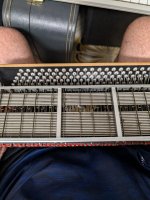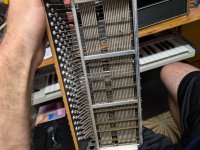I have had this dilapidated langatone accordion for 10 years. I learned how to play on it even though it is still as broken as it was 10 years ago. I decided to take it apart to learn how the bass mechanism works. I put it back together and it still works!
Anyone know why there are so many long cylinder tubes that open the valves? Also I noticed, before I took out the bass machine, the required bass notes would drop to form the required note however now they drop however they don't drop as far down as they used to. Perhaps the bars going sideways to open valves need lubricant? They seemed very stiff.
Anyone know why there are so many long cylinder tubes that open the valves? Also I noticed, before I took out the bass machine, the required bass notes would drop to form the required note however now they drop however they don't drop as far down as they used to. Perhaps the bars going sideways to open valves need lubricant? They seemed very stiff.



